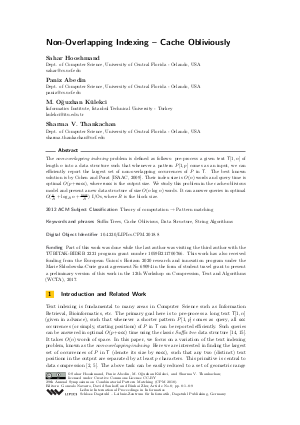Non-Overlapping Indexing - Cache Obliviously
Authors Sahar Hooshmand, Paniz Abedin, M. Oguzhan Külekci, Sharma V. Thankachan
-
Part of:
Volume:
29th Annual Symposium on Combinatorial Pattern Matching (CPM 2018)
Part of: Series: Leibniz International Proceedings in Informatics (LIPIcs)
Part of: Conference: Annual Symposium on Combinatorial Pattern Matching (CPM) - License:
 Creative Commons Attribution 3.0 Unported license
Creative Commons Attribution 3.0 Unported license
- Publication Date: 2018-05-18
File

PDF
LIPIcs.CPM.2018.8.pdf
- Filesize: 465 kB
- 9 pages
Document Identifiers
Subject Classification
ACM Subject Classification
- Theory of computation → Pattern matching
Keywords
- Suffix Trees
- Cache Oblivious
- Data Structure
- String Algorithms
Metrics
- Access Statistics
-
Total Accesses (updated on a weekly basis)
0Document
0Metadata
Abstract
The non-overlapping indexing problem is defined as follows: pre-process a given text T[1,n] of length n into a data structure such that whenever a pattern P[1,p] comes as an input, we can efficiently report the largest set of non-overlapping occurrences of P in T. The best known solution is by Cohen and Porat [ISAAC, 2009]. Their index size is O(n) words and query time is optimal O(p+nocc), where nocc is the output size. We study this problem in the cache-oblivious model and present a new data structure of size O(n log n) words. It can answer queries in optimal O(p/(B)+log_B n+nocc/B) I/Os, where B is the block size.
Cite As Get BibTex
Sahar Hooshmand, Paniz Abedin, M. Oguzhan Külekci, and Sharma V. Thankachan. Non-Overlapping Indexing - Cache Obliviously. In 29th Annual Symposium on Combinatorial Pattern Matching (CPM 2018). Leibniz International Proceedings in Informatics (LIPIcs), Volume 105, pp. 8:1-8:9, Schloss Dagstuhl – Leibniz-Zentrum für Informatik (2018)
https://doi.org/10.4230/LIPIcs.CPM.2018.8
BibTex
@InProceedings{hooshmand_et_al:LIPIcs.CPM.2018.8,
author = {Hooshmand, Sahar and Abedin, Paniz and K\"{u}lekci, M. Oguzhan and Thankachan, Sharma V.},
title = {{Non-Overlapping Indexing - Cache Obliviously}},
booktitle = {29th Annual Symposium on Combinatorial Pattern Matching (CPM 2018)},
pages = {8:1--8:9},
series = {Leibniz International Proceedings in Informatics (LIPIcs)},
ISBN = {978-3-95977-074-3},
ISSN = {1868-8969},
year = {2018},
volume = {105},
editor = {Navarro, Gonzalo and Sankoff, David and Zhu, Binhai},
publisher = {Schloss Dagstuhl -- Leibniz-Zentrum f{\"u}r Informatik},
address = {Dagstuhl, Germany},
URL = {https://drops.dagstuhl.de/entities/document/10.4230/LIPIcs.CPM.2018.8},
URN = {urn:nbn:de:0030-drops-87009},
doi = {10.4230/LIPIcs.CPM.2018.8},
annote = {Keywords: Suffix Trees, Cache Oblivious, Data Structure, String Algorithms}
}
Author Details
Funding
Part of this work was done while the last author was visiting the third author with the TÜBİTAK-BİDEB 2221 program grant number 1059B211700766.
This work has also received funding from the European Union’s Horizon 2020 research and innovation program under the Marie Skłodowska-Curie grant agreement No 69094 in the form of student travel grant to present a preliminary version of this work in the 12th Workshop on Compression, Text and Algorithms (WCTA), 2017.
References
- Alok Aggarwal and Jeffrey Scott Vitter. The input/output complexity of sorting and related problems. Commun. ACM, 31(9):1116-1127, 1988. URL: http://dx.doi.org/10.1145/48529.48535.
-
Alberto Apostolico and Franco P Preparata. Data structures and algorithms for the string statistics problem. Algorithmica, 15(5):481-494, 1996.

- Michael A. Bender, Erik D. Demaine, and Martin Farach-Colton. Cache-oblivious b-trees. SIAM J. Comput., 35(2):341-358, 2005. URL: http://dx.doi.org/10.1137/S0097539701389956.
- Gerth Stølting Brodal and Rolf Fagerberg. Cache-oblivious string dictionaries. In Proceedings of the Seventeenth Annual ACM-SIAM Symposium on Discrete Algorithms, SODA 2006, Miami, Florida, USA, January 22-26, 2006, pages 581-590. ACM Press, 2006. URL: http://dl.acm.org/citation.cfm?id=1109557.1109621.
- Hagai Cohen and Ely Porat. Range non-overlapping indexing. In Yingfei Dong, Ding-Zhu Du, and Oscar H. Ibarra, editors, Algorithms and Computation, 20th International Symposium, ISAAC 2009, Honolulu, Hawaii, USA, December 16-18, 2009. Proceedings, volume 5878 of Lecture Notes in Computer Science, pages 1044-1053. Springer, 2009. URL: http://dx.doi.org/10.1007/978-3-642-10631-6_105.
-
Maxime Crochemore. String-matching on ordered alphabets. Theoretical Computer Science, 92(1):33-47, 1992.

- Matteo Frigo, Charles E. Leiserson, Harald Prokop, and Sridhar Ramachandran. Cache-oblivious algorithms. In 40th Annual Symposium on Foundations of Computer Science, FOCS '99, 17-18 October, 1999, New York, NY, USA, pages 285-298. IEEE Computer Society, 1999. URL: http://dx.doi.org/10.1109/SFFCS.1999.814600.
- Matteo Frigo, Charles E. Leiserson, Harald Prokop, and Sridhar Ramachandran. Cache-oblivious algorithms. ACM Trans. Algorithms, 8(1):4:1-4:22, 2012. URL: http://dx.doi.org/10.1145/2071379.2071383.
-
Arnab Ganguly, Rahul Shah, and Sharma V Thankachan. Succinct non-overlapping indexing. In Annual Symposium on Combinatorial Pattern Matching, pages 185-195. Springer, 2015.

- Dov Harel and Robert Endre Tarjan. Fast algorithms for finding nearest common ancestors. SIAM J. Comput., 13(2):338-355, 1984. URL: http://dx.doi.org/10.1137/0213024.
- Orgad Keller, Tsvi Kopelowitz, and Moshe Lewenstein. Range non-overlapping indexing and successive list indexing. In Frank K. H. A. Dehne, Jörg-Rüdiger Sack, and Norbert Zeh, editors, Algorithms and Data Structures, 10th International Workshop, WADS 2007, Halifax, Canada, August 15-17, 2007, Proceedings, volume 4619 of Lecture Notes in Computer Science, pages 625-636. Springer, 2007. URL: http://dx.doi.org/10.1007/978-3-540-73951-7_54.
- Udi Manber and Eugene W. Myers. Suffix arrays: A new method for on-line string searches. SIAM J. Comput., 22(5):935-948, 1993. URL: http://dx.doi.org/10.1137/0222058.
- Yakov Nekrich and Gonzalo Navarro. Sorted range reporting. In Fedor V. Fomin and Petteri Kaski, editors, Algorithm Theory - SWAT 2012 - 13th Scandinavian Symposium and Workshops, Helsinki, Finland, July 4-6, 2012. Proceedings, volume 7357 of Lecture Notes in Computer Science, pages 271-282. Springer, 2012. URL: http://dx.doi.org/10.1007/978-3-642-31155-0_24.
- Esko Ukkonen. On-line construction of suffix trees. Algorithmica, 14(3):249-260, 1995. URL: http://dx.doi.org/10.1007/BF01206331.
- Peter Weiner. Linear pattern matching algorithms. In 14th Annual Symposium on Switching and Automata Theory, Iowa City, Iowa, USA, October 15-17, 1973, pages 1-11. IEEE Computer Society, 1973. URL: http://dx.doi.org/10.1109/SWAT.1973.13.
